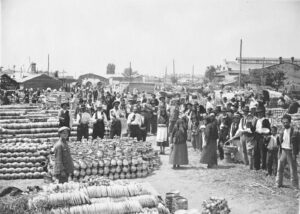Denaroc and Negot in Bucharest of the past

The fairs that were organized in Bucharest, and not only, were the only way to get out of the community, to meet people from various areas of the country, to bring together social structures and ethnicities, facilitating and favoring both an economic exchange and an exchange of information that was transmitted directly. The « Fair of Moșilor » in Bucharest was born from the overlap of the « fair outside » (attested from the seventeenth century at the eastern edge of the city), which was called so to differentiate from the old « fair inside » located near the royal court, thus becoming an active and rich commercial center.
Within it were goods of different invoices (from embroidery and expensive silk to oriental scents and perfumes), marking the place of commemoration of the dead, devoted by the alleged jobs held by Matei Basarab (1632-1654) in memory of the soldiers fallen in the fight from 1632. until the 19th century. Also, the land on which the « fair outside » was held was extended in a constant and always moved to the East, with the development of the capital.
At the end of the nineteenth century, the fair was held at the Moșilor barrier. Organized for a long time rudimentary, the fair acquires at the beginning of the twentieth century the appearance of semicircles leading to the stand for the royal family, on the occasion of the visit from Joia Moșilor, this being the climax of the event. Then, around the goods of the countless craftsmen from all the ethnographic areas of the country were around: spoons, dogs, potters, blacksmiths, etc. During the interwar period, the fair turns into an annual exhibition of craftsmen and small industrials.

Also, in the Bucharest urban, there were several markets that were initially called « fairs », such as « Târgul de Sus », « Târgul de Jos », « Fair outside » or « Cucului Fair », while the space for animal trade was known as « Obor ». The word « market », of Italian origin (« Piazza »), was used from the beginning of the 19th century, and the edilitary provisions included in the organic regulation provided for the establishment of markets located either on the periphery, intended for wood, hay or coal, or in different places inside the city, for sales, for sales, Keep cleaning on Bucharest streets. It was the first coherent vision of development of Bucharest, which was trying to start shy on the way of modernization.

The evolution of the Bucharest markets reveals interesting aspects regarding the development of the city, the way in which the local authorities have conceived and applied urban policies, economic realities and, last but not least, social transformations. For the Romanian society traumatized by the food shortage during the communist regime, « market walking » can be appreciated a reflex of those times, resulting from the desperate need to buy something.
Therefore, over time, the fairs and markets in Bucharest have become important cultural and economic nodes in which people gather to sell and buy goods, socialize and experience local traditions.
Even though some of the markets have been lost in the dark of time, the Obor Square today, respectively the area of the « Fair of Moșilor » represents a place with a historical and symbolic-memorial value for the city of Bucharest. Over time, it has gone through multiple transformations, but what has remained unchanged is the commercial (free market) function with agricultural and manufacturing products supporting the connection between urban and rural productive activity, but also a special significance: a memory of the « Fair of Moșilor », a place of special supply to the custom Although the « Fair of Moșilor » was replaced during the communist period with the « Harvest Harvest », the initial significance of the Christian holiday could not be removed from the collective mind, keeping continued.
Through this exhibition project, we bring to the public’s attention both the atmosphere of the fairs and the importance of the markets in Bucharest by exposing documents, photographs, lithographs, but also of other objects that create aspects of cultural activities from ancient times. Thus, you will be able to discover some historical landmarks related to the ambience of fairs and markets organized in Bucharest.
The exhibition organized by the Bucharest Municipality Museum can be visited on April 25 to October 26, 2025, at the Suțu Palace (IC Brătianu Boulevard, no. 2).
Article written by Dr. Silvia Iordache, head of urban anthropology section, MMB









